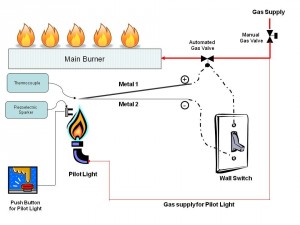If you have a gas fireplace in your house, I have something surprising to tell you about it. The switch on the wall which turns on the flame is not connected to the electricity in your house. Understanding how this switch works requires an explanation of both the thermoelectric and piezoelectric effects. Who knew you had such sophisticated physics occurring in your house?
Before we proceed, a brief explanation of electricity is in order. Electricity is the flow of electrons through a conductor like a copper wire. In order to induce electrons to move you need to create a zone with a high concentration of elections and another with a low concentration. The difference in electron concentration between the two zones is the voltage. The larger the concentration difference, the higher the voltage. If you connect these two zones with a conductive material, electrons will flow from the zone with high concentration to the zone with low concentration. That’s electricity in a nutshell.
There are several ways to create voltage. I reviewed how power plants do it in an earlier column, Electricity Production 101. Batteries make voltage using chemical reactions. Solar panels make voltage by capturing energy from the sun. Your gas fireplace generates its own voltage in two ways, by deforming crystals and by heating dissimilar metals.
Let’s start our discussion of the fireplace by lighting the pilot. I’ll be referring to the figure above several times. The first step is to open the hand valve to the main gas supply. This allows a small amount of gas to flow to the pilot light through a small pipe depicted in the figure above with the thin red line. Once the gas is flowing you need an ignition source to light it. Most modern fireplaces use a spark from a piezoelectric crystal. Time for our next lesson.
A discussion of the physics involved in piezoelectric effect could go on for a while, so let me skip some steps. Materials at equilibrium have a uniform distribution of electrons within them. Therefore, they have no voltage. There are some crystalline and ceramic materials that, when mechanically compressed, develop a non-uniform distribution of electrons (voltage). This is the piezoelectric effect.
In your fireplace there should be a button to push to light the pilot. This button is connected to a mechanism which compresses a piezoelectric crystal. The voltage induced in the crystal is connected to two small metal prongs above the pilot. Since the gap between the prongs is small, a spark can jump across, allowing the electrons to move from a zone of high to low concentration, which lights the pilot.
Now that the pilot is lit, let’s talk about how to light the main flame. Above your pilot light you should see a small metal cylinder with two wires coming out of the back. These two wires are joined together inside the cylinder to make a thermocouple. To understand how a thermocouple works we need to learn about the thermoelectric effect.
If you heat one end of a wire, electrons within the wire will migrate from the hot end towards the cool end. (Self preservation at the atomic scale?) The extent to which this electron migration occurs is dependent on the composition of the metal wire. To make a thermocouple you take two wires made of different metals and join them at one end. (1) (See the picture above again.) If you now place the union of the two wires above the pilot light, electrons in both wires will move away from the heat, but they will do so to different extents. This is the thermoelectric effect. (2) The cool ends of the wires now have a voltage difference between them and, thus, can be used to operate an electric circuit in same manner that you could use a battery.
As you can see from the diagram, the voltage from the thermocouple is connected to the automated gas valve, but the circuit can be opened or closed using the wall switch. When you flip the wall switch to the on position is completes the circuit and the voltage from the thermocouple opens the automated valve(3)letting gas flow to the main burner where it is ignited by the pilot light. Now you’ve got yourself a nice, warm fire. Enjoy!
Have a comment or question? Use the interface below or send me an email to commonscience@chapelboro.com.
(1) The most commonly used thermocouple is called a type K. The two metals are an alloy called chromel which is 90% nickel and 10% chromium and another called alumel which is 95% nickel, 2% manganese, 2% aluminum, and 1% silicon.
(2) If you have been reading my previous columns, you may recall that I briefly discussed the thermoelectric effect in my column on Voyager. Voyager uses nuclear decay to create heat which is applied to thermocouples to generate voltage to run its equipment.
(3) I had to restrain myself from explaining why a voltage could open up a valve in the main body of the column. Here in the footnotes I figure I have more freedom to ramble on. This type of valve is called a solenoid valve. It consists of a coil of wire which encircles a magnet. When you apply voltage to the coil it generates a magnetic field. The magnetic field from the coil pushes on the magnet which opens the valve to let the gas through. When you flip the wall switch to the off position no more voltage is applied to the coil so the magnet falls back to its original position which shuts off the flow of gas to the main burner and the flame is extinguished.



Comments on Chapelboro are moderated according to our Community Guidelines